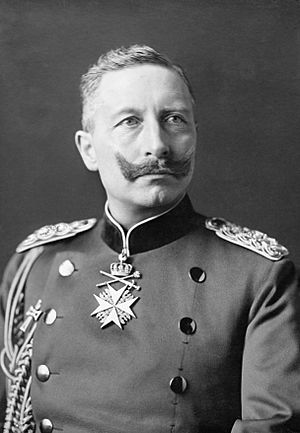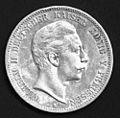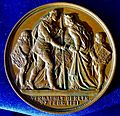Wilhelm II of Germany facts for kids
Quick facts for kids Wilhelm II |
|||||
|---|---|---|---|---|---|

A portrait of Wilhelm II by T. H. Voigt
|
|||||
| German Emperor King of Prussia |
|||||
| Reign | 15 June 1888 – 9 November 1918 | ||||
| Predecessor | Frederick III | ||||
| Chancellors | |||||
| Born | 27 January 1859 Kronprinzenpalais, Berlin, Kingdom of Prussia |
||||
| Died | 4 June 1941 (aged 82) Huis Doorn, Doorn, Nazi-occupied Netherlands |
||||
| Burial | 9 June 1941 Huis Doorn, Doorn |
||||
| Spouse |
Princess Augusta Victoria of Schleswig-Holstein-Sonderburg-Augustenburg
(m. 1881; died 1921)Princess Hermine Reuss of Greiz
(m. 1922) |
||||
| Issue |
|
||||
|
|||||
| House | Hohenzollern | ||||
| Father | Frederick III, German Emperor | ||||
| Mother | Victoria, Princess Royal | ||||
| Religion | Calvinism (Prussian United) | ||||
| Signature |  |
||||
Wilhelm II (born Friedrich Wilhelm Viktor Albert von Hohenzollern) was the last German Emperor and King of Prussia. He ruled from 1888 to 1918. He was born on January 27, 1859, and passed away on June 4, 1941. After his rule, he moved to the Netherlands and gave up his titles as King and Emperor. He is buried in Huis Doorn, as he did not want to be buried in Nazi Germany.
Wilhelm was the oldest child of Prince Frederick of Prussia and Princess Victoria. His mother was the eldest daughter of Queen Victoria of the United Kingdom. Wilhelm was born with a left arm that was not fully developed. In 1881, he married Augusta Victoria, and they had seven children together. He went to school at the Kassel Gymnasium and later studied at the University of Bonn.
Contents
Becoming Emperor: Wilhelm's Early Rule
Wilhelm became the leader of Germany in 1888 after his father died. He had different ideas from his father's long-time chief minister, Otto von Bismarck. Bismarck was a very powerful figure who had helped unite Germany. Wilhelm decided to remove Bismarck from his position in 1890. This showed that Wilhelm wanted to be in charge and make his own decisions for Germany.
Wilhelm's Vision for Germany
Wilhelm strongly believed in making Germany's military stronger, especially its Navy. He wanted Germany to be a major world power. He thought a strong military would help Germany gain more influence and respect around the globe. This focus on military strength played a big role in the events leading up to World War I.
Wilhelm II and World War I
Wilhelm II was the leader of Germany during World War I. This was a huge global conflict that lasted from 1914 to 1918. His decisions and actions as emperor had a major impact on how the war started and how it was fought. As the war progressed, Germany faced many challenges. Eventually, Wilhelm had to give up his power in 1918, marking the end of his rule and the German Empire.
Life After the Throne
After giving up his titles, Wilhelm II lived in exile in the Netherlands. He spent the rest of his life there, away from the political spotlight. He passed away in 1941 at his home, Huis Doorn.
Images for kids
-
"Dropping the Pilot", a cartoon by Sir John Tenniel, published in the British magazine Punch, 29 March 1890, two weeks after Bismarck's dismissal
-
Wilhelm talking with Ethiopians at the Tierpark Hagenbeck in Hamburg in 1909
-
The Nine Sovereigns at Windsor for the funeral of King Edward VII, photographed on 20 May 1910. Standing, from left to right: King Haakon VII of Norway, Tsar Ferdinand of the Bulgarians, King Manuel II of Portugal and the Algarve, Kaiser Wilhelm II of Germany and Prussia, King George I of the Hellenes and King Albert I of the Belgians. Seated, from left to right: King Alfonso XIII of Spain, King George V of the United Kingdom and King Frederick VIII of Denmark.
-
1898 Chinese imperialism cartoon: A Mandarin official helplessly looks on as China, depicted as a pie, is about to be carved up by Queen Victoria (Britain), Wilhelm (Germany), Nicholas II (Russia), Marianne (France), and a samurai (Japan)
-
Wilhelm with Nicholas II of Russia in 1905, wearing the military uniforms of each other's army
-
Wilhelm in Jerusalem during his state visit to the Ottoman Empire, 1898
-
Wilhelm and Winston Churchill during a military autumn manoeuvre near Breslau, Silesia (Wrocław, Poland) in 1906
-
Caricature by Olaf Gulbransson 1909: "Manoeuvre: Emperor William II explains the enemy's positions to Prince Ludwig of Bavaria"
-
Hindenburg, Wilhelm, and Ludendorff in January 1917
See also
 In Spanish: Guillermo II de Alemania para niños
In Spanish: Guillermo II de Alemania para niños
























